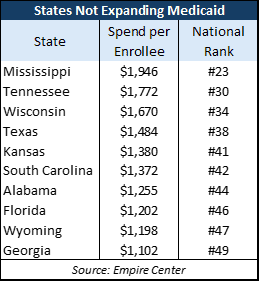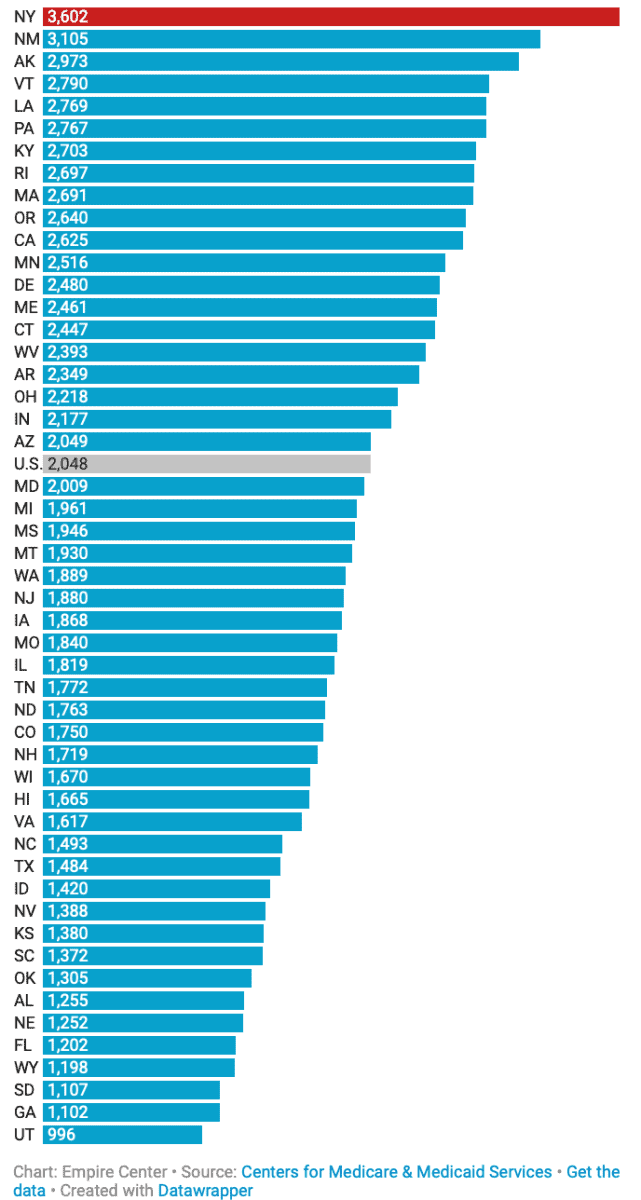New York’s Empire Center analyzed data from the Centers for Medicare and Medicaid Services and found that the ten states that have yet to expand Medicaid spend less per participant than the national average.
 According to 2020 figures, the latest available, states spend an average of $2,048 per enrollee per year. New York spends the most at $3,602, and Utah the least at $996. The ten states that have still not expanded the program, how much they spend per enrollee, and their national rank are listed in the adjacent table. Five others – Oklahoma, Missouri, South Dakota, North Carolina, and Nebraska – expanded Medicaid later than FY 2020 and also spent less than the national average. Note that among the bottom ten in Medicaid spending, nine of them had not expanded the program by FY 2020, and the other, Utah, is operating under a Section 1115 waiver, according to the Kaiser Family Foundation.
According to 2020 figures, the latest available, states spend an average of $2,048 per enrollee per year. New York spends the most at $3,602, and Utah the least at $996. The ten states that have still not expanded the program, how much they spend per enrollee, and their national rank are listed in the adjacent table. Five others – Oklahoma, Missouri, South Dakota, North Carolina, and Nebraska – expanded Medicaid later than FY 2020 and also spent less than the national average. Note that among the bottom ten in Medicaid spending, nine of them had not expanded the program by FY 2020, and the other, Utah, is operating under a Section 1115 waiver, according to the Kaiser Family Foundation.
Pressure on states to expand the Obamacare initiative is intense, but evidence, such as this chart, shows claims of lower costs after expansion are unfounded.

Forbes: states that expanded Medicaid spend 76% more per enrollee
According to an April 2022 article in Forbes:
“The cost of expansion has far exceeded original estimates. States are on the hook for much more than they bargained for. In the states that have expanded, the program covers twice as many people and costs 76% more per enrollee than initially projected.
“Many of these additional enrollees may be ineligible for Medicaid. A 2015 federal audit of a sample of beneficiaries in Medi-Cal, California’s Medicaid program, found that half were either improperly or potentially improperly enrolled. A more recent audit found there were eligibility review errors in nearly 30% of enrollee files in expansion states, according to Brian Blase, a former economic advisor to President Trump.
“Those errors have cost taxpayers a fortune. Last year, more than one in every five dollars the government spent on Medicaid was “improper.” That accounts for roughly $99 billion in fraudulent and erroneous payments—an amount equivalent to the GDP of Ecuador.”
The argument that expansion improved health outcomes is also challenged by Forbes:
“That’s partly because Medicaid pays doctors 62 cents for every dollar that private plans do. As a result, just 70% of providers were willing to accept new Medicaid patients as of 2019—compared to the 90% who were willing to accept privately insured patients.
“That may seem inconsequential. But by expanding Medicaid, states have dramatically increased the number of patients on the program’s rolls. Meanwhile, the number of doctors willing to see those patients has largely stayed the same. That’s a recipe for long waits—and ultimately poor health outcomes.”
In Kansas, despite expansion being a legislative priority of Governor Laura Kelly throughout her term, the Kansas Legislature has resisted the move. Proponents argue the federal government has promised to pay 100% of the costs of expansion for the first two years and 90% thereafter. But an editorial from Kansas Policy Institute, owners of The Sentinel, finds two flaws in that position:
“For one, Kansans pay their federal income taxes too: though it’s at a much larger scale, it still would be an increase in spending and cost for them. That’s not even considering the absolute glut of federal debt and the interest growing on it. Additionally, Congress can reduce the 90% reimbursement rate at any time; for example, the federal government pays about 60% of Medicaid costs in Kansas currently.
“In 2022, the Kansas Health Institute estimated that the 10-year cost of Medicaid expansion at $320 million. But at any point, the federal government could place the total 10-year cost of $13 billion in for the state budget to absorb and walk away.”


